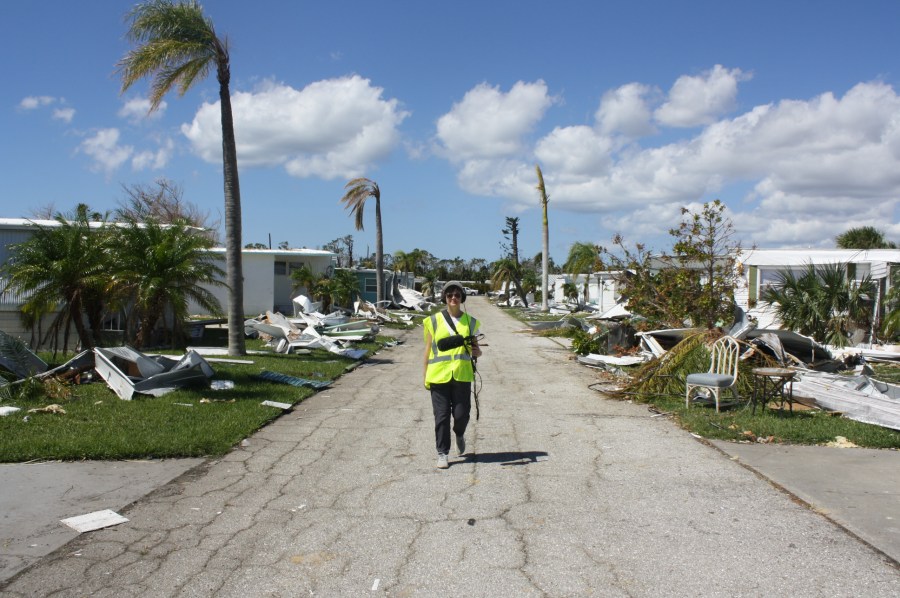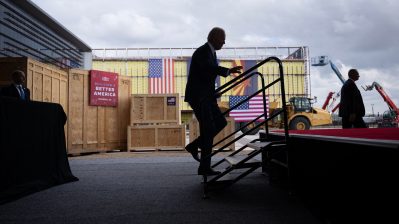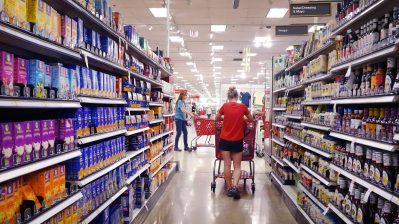
In late September, a massive hurricane was churning toward southwest Florida, threatening the Tampa Bay region where more than 3 million people live.
A direct hit on Tampa was one of those doomsday scenarios that could bring a 10-foot wall of water coursing through streets, take countless lives, and cost billions of dollars in economic damage.
Right before Hurricane Ian made landfall, the storm intensified — with wind speeds just shy of a category 5 hurricane — and turned south, hitting the less populated area around Cayo Costa in Lee County. But Ian still devastated the coast and killed more than 120 people, making it Florida’s deadliest storm in 90 years.
As the storm was making landfall, we flew first to Boston, where we followed a team of catastrophe modelers as they watched the storm and calculated potential losses.
The early estimate was staggeringly high: $100 billion in losses. Only about $63 billion of that is insured. But that was just a number on a screen.
To really understand the data points, we went to the Gasparilla Mobile Estates in Placida, FL, a mobile home park near the coast that was practically flattened by the storm. We talked to residents who lost everything. Most did not have insurance.
This episode is a season prologue of sorts. We’ve been reporting for the past six months on Miami, a few hours southeast of where the hurricane tore through the state. But we knew we had to cover this hurricane and the aftermath because the next hurricane could hit Miami. And we wanted to understand how people decide to stay or go; rebuild or retreat.
In season two of How We Survive, we follow the money to the end of the world. In this case, South Florida. New episodes are out every Wednesday. Be sure to follow us on your favorite podcast app and tell a friend if you’re enjoying the show.
How We Survive Season 0 Prologue Transcript
Note: Marketplace podcasts are meant to be heard, with emphasis, tone and audio elements a transcript can’t capture. Transcripts are generated using a combination of automated software and human transcribers, and may contain errors. Please check the corresponding audio before quoting it.
Amy Scott: In late September, a massive hurricane was churning towards the southwest coast of Florida.
Archival: Evacuations are mandatory…
Amy Scott: Looks like it was going to be bad.
Archival: Current track has Ian becoming a major hurricane in the Gulf of Mexico in the coming days…
Amy Scott: Really bad.
Archival: Winds are at 120 miles an hour… This is just ten miles an hour away from becoming a category 4 hurricane.
Amy Scott: Early on, it was projected to directly hit the Tampa Bay area, where more than 3-million people live. Something that hasn’t happened in more than a century.
Archival: … mass evacuations, hundreds of thousands of people being asked to leave their homes…
Amy Scott: By the time Hurricane Ian was forming in the ocean, I’d been reporting on the climate crisis and housing in South Florida for six months. So I was anxious to see firsthand the aftermath of the storm. But there was somewhere else I needed to go first. Boston.
Karen Clark: Hi, come on in. Hi hi, good to see you.
Amy Scott: This is Karen Clark. She’s an economist and I came to see her because 30 years ago she transformed the insurance industry by using computer modeling to more accurately predict losses from major disasters. A direct hit on Tampa is one of those doomsday scenarios Karen has been warning about for years. Storm surge could bring a wall of water coursing through streets. Economic damage could reach over $175 billion. I wanted to watch how Karen’s team tracked such a storm in real time.
Karen Clark: There’s never a dull moment in catastrophe modeling, which keeps it so interesting.
Amy Scott: For days before and after Ian made landfall, Karen’s team was holed up in their war room in Boston’s Back Bay. Okay, it’s really just an office, a big open space with standing desks and wall-to-wall windows. You can see a sliver of the Atlantic Ocean. There are TVs on in every room, playing the weather channel.
Archival: We’ve got flash flood warnings that in effect has been…
Amy Scott: I arrived early the morning after landfall. Tampa is no longer in the crosshairs.
Karen Clark: What happened is that the track changed.
Amy Scott: The storm hit land in a less populated area more than 100 miles south.
Speaker 1: Cape Coral, City of Fort Myers, they got really, really inundated and really devastated.
Amy Scott: But with much stronger winds than expected, just shy of a Category Five.
Archival: The fifth strongest ever to hit the US.
Amy Scott: In a corner of Karen’s office, atmospheric scientists are tracking the storm’s path, eyes glued to their computer screens for updates from the National Hurricane Center. They plugged the projected track along with wind speeds, storm surge and rainfall into a computer model to create what they call footprints of the storm. And then based on a ridiculous amount of data about the properties in the storm’s path, things like roof type, age, construction materials, even whether there’s a garage door, the model estimates how much damage the hurricane will cause. Karen says these estimates are used mostly by insurance companies to prepare for what comes next.
Karen Clark: It’s very important for insurers to get right in there as soon as they can after the event and help homeowners and commercial property owners, you know, protect their property, get them back on their feet. They know where they need to position people and where they need to send their adjusters.
Amy Scott: Given the chaos and destruction unfolding in Florida…
Archival: There are downed trees literally everywhere… Look at the wind… You don’t really see anything out here.
Amy Scott: It’s surprisingly quiet in this war room. There’s a stillness in the air, a sense of anticipation and purpose.
Tanner Hanwright: This is the not as glamorous part of the process. It’s just editing text files.
Amy Scott: Tanner Hanwright is a senior data analyst. He’s getting ready to send out the latest projections to clients, so they can estimate their claims.
Amy Scott: How does it feel to be processing this kind of damage?
Tanner Hanwright: It’s interesting, because it’s, it’s really hard to kind of wrap your head around what this actually means without being there. It’s hard to kind of differentiate what does $20 billion of loss look like compared to $30 billion of loss.
Amy Scott: Yeah, because all these numbers, behind all these numbers are people who have lost their houses or their, in some cases, their lives.
Tanner Hanwright: One of the most interesting and kind of exciting parts about the job is covering these events in real time, and kind of putting out these reports. But then you also have to grapple with, like, something that you find exciting at work is the worst day of someone’s life.
Amy Scott: I’m Amy Scott. This is How We Survive, a podcast for Marketplace where we’re following the money to the end of the world. In this case, South Florida. This is episode zero, Tracking a Catastrophe. It’s a prologue to the season, which is all about sea level rise in South Florida, focusing on Miami. When it comes to climate change, Miami is considered one of the most endangered coastal cities in the world.
Speaker 2: We’re one hurricane away from game over.
Speaker 3: Large amounts of neighborhoods in the Miami Metro, they’re going to be unlivable.
Amy Scott: And then, right before our season launch, Hurricane Ian ripped through the state, just north of where we’ve been reporting.
This hurricane was devastating, but it shouldn’t have come as a surprise. Climate scientists have been shouting increasingly dire warnings for years now. The world is heating up. Glaciers are melting, seas are rising, and hurricanes are getting stronger, wetter and more destructive. This season, we’re looking at how South Florida can survive what’s coming, why this part of the country is so vulnerable, why it was developed in the first place, and what people are doing to find solutions and adapt, at least for as long as they can. But before diving into that, we’re surveying the immediate aftermath of a hurricane to understand what’s really at risk for the people living through it.
As hurricane Ian was tearing a path of destruction through Florida, Karen Clark and her team of catastrophe modelers were looking at the data and calculating initial loss estimates. A few days after landfall, their number was jaw-droppingly high, more than $100 billion in economic damage. Only about $63 billion of that is insured. But that was just a number on a screen. To get an idea of what these data points look like on the ground. I went to Florida with Senior Producer Caitlin Esch.
Caitlin Esch: Oh wow, These mobile homes are just wrecked,
Amy Scott: Just destroyed. This is just rubble.
Caitlin Esch: Oh my god. Oh my god. It’s just a couch and a car. I hope no one was in there.
Amy Scott: We met up with a team Karen sent to assess the damage in person.
Sara Sienkiewicz: Roof. Metal, Windows gone.
Amy Scott: Sara Sienkiewicz is an atmospheric scientist with Karen Clark’s company. And she’s walking through the wreckage of Gasparilla Mobile Estates in Placida, Florida, a mobile home park right near the coast.
Sara Sienkiewicz: Definitely metal siding. Carport gone.
Amy Scott: She’s holding a clipboard, making an entry for every trailer, meticulously documenting the damage while a colleague takes detailed photographs.
Amy Scott: What data points are you taking?
Sara Sienkiewicz: So the data points that we’re looking at are the state of the roof and what the roof is made out of – the roofing material. The state of the wall, so if there’s any siding missing. And then structural damage.
Amy Scott: Sara says this data will be folded into the models and will help insurance companies set more accurate prices based on risk, which could ultimately help homeowners.
Sara Sienkiewicz: If we have actual data to support what events like this truly cost, then insurance companies can’t make up numbers because we have the data to actually support what those numbers should actually be.
Amy Scott: The team is working their way down the coast, assessing how different neighborhoods held up to high wind speeds and storm surge. The mobile home park in Placida got it bad.
Sara Sienkiewicz: Very high wind speeds, very close to the eyewall.
Amy Scott: The “eyewall” is the ring around the center or the eye of a hurricane. The eye itself is relatively calm, but the eyewall is the most intense part of the storm. With the highest wind speeds.
Sara Sienkiewicz: I think 110 to 120 miles per hour. You wouldn’t be able to stand up. And then there’s higher gusts in the heavy rain that is found within the eyewall.
Amy Scott: The destruction is staggering. Parts of this park are flattened. Mobile homes are reduced to heaps of splintered wood, crumpled metal, and furniture. Some homes are still standing but the roofs are torn off. Others, the walls are peeled back to reveal a bed or kitchen for a dining set, more or less intact. Like a doll house with an open side.
Caitlin Esch: Yeah, it’s kind of trippy. Sometimes it looks like from one angle that it’s okay, and then you turn around and you realize the whole side is gone.
Sara Sienkiewicz: Because the winds were probably predominantly coming from a single direction but gusting intermittently.
Amy Scott: As Sara takes stock of the physical damage, we start to learn of the human toll.
Amy Scott: Is this your house here?
Patti Sylvia: Yeah, that was my house.
Amy Scott: This is Patti Sylvia. Her teal front door is still standing, but not much else. You can see the lovingly painted hot pink walls inside.
Amy Scott: I just love how you decorated in there. It’s just so colorful.
Patti Sylvia: It’s too bad you can’t see the bathroom. The bathroom is I-don’t-even-need-to-turn-the-lights-on-at-night orange.
Shelly: A bright and sunny personality.
Amy Scott: Patti and her friend Shelly are hauling a few precious belongings out of the house and into a car.
Patti Sylvia: Oh my mom and dad’s wedding picture. They’re good folks. They really were. All my life I’ve looked at their wedding picture on my dad’s nightstand. And I’ve just always loved it. So when my father died and we were cleaning out their house, I said to my siblings, can I have this? And they’re like, Yeah, take it.
Caitlin Esch: And it made it out. I mean, the rest of your house…
Patti Sylvia: Yeah, I mean, the picture is ruined, but I can still see their faces.
Amy Scott: She’s also managed to salvage an art project – a needle work picture she made a long time ago.
Patti Sylvia: This is crewel work. And I did this probably in my young years or my teens. I brought this down to Florida from Massachusetts. And she’s going back to Massachusetts.
Sara Sienkiewicz: It’s so beautiful. It’s like a tiger face…
Patti Sylvia: Yeah, with all the flowers. Yeah, and each flower with different stitches. So you learned a lot of different stitches as you went through it. This was really cool.
Amy Scott: Patti recently moved to the park to live year-round with her husband, who was battling Parkinson’s disease. He died in January. Just 12 days later, a freaking tornado swept through the park and destroyed several buildings.
Patti Sylvia: Eight months later…
Amy Scott: Then in September…
Patti Sylvia: The hurricane pushes me out.
Amy Scott: Hurricane Ian.
Patti Sylvia: But I have wonderful, wonderful friends that have taken me in for the week. And then I’m going up north where other friends are going to take me in. And then from there, I’ll find something to live in. I had my husband buried down here. And I hate to leave him, but there’s really nothing I can do about it.
Amy Scott: As we’re making our way through the park, a friendly lady rolls up in a golf cart. She’s wearing a tank top and shorts with a knee brace. An American flag flies on the back of the cart.
Cindy Galeone: My name is Cindy Galeone. We’ve owned here for 19 years, and we’ve been coming to this park for 21.
Amy Scott: She’s 65 years old, lives in the park year round, and just retired from her job as a school teacher.
Amy Scott: So we’re looking around here at the damage. I mean, some of these homes were just absolutely destroyed. How did yours fare?
Cindy Galeone: By the grace of God, my unit is still there. We don’t know how. It’s there. Because everything around us is just totally gone. We’re not sure why. Maybe because I put a cross in the front of the room, I put a cross in the back of the room. And I prayed to God that it would at least be this way to get my belongings and he listened to me.
Amy Scott: Cindy’s trailer may be standing but the park isn’t livable. She’s crashing with friends at the moment.
Cindy Galeone: We’re packing our things and then as soon as we find someplace to live, then we’re going to move on, you know, hopefully get movers and move it. Unfortunately, you can’t bring everything with you. So we’re picking and choosing what we’re taking. Enough for us to survive until we’ll be able to get settled.
Amy Scott: I’m curious about insurance. If you, if your home is okay…?
Cindy Galeone: First of all, insurance – this is a flood zone. So insurance is – there’s a few units that had insurance. But the majority of the people here, no.
Amy Scott: So are you saying that you don’t have insurance on the home?
Cindy Galeone: I lost about $100,000 and there are people here that the units probably – if they’re around the water, $150,000, $175,000, maybe $200,000 they’ve lost. It’s very sad.
Amy Scott: We hear that a lot around the park.
Dave Schmidt: It was very difficult, almost totally impossible to get insurance. So it’s uninsured. So we lost everything.
Amy Scott: Dave Schmidt is sitting outside his home, listening to the radio, chatting with people passing by. He takes me inside, shows me the damage.
Amy Scott: Oh my! Yeah. So insulation hanging down from the ceiling. Windows blown in.
Amy Scott: Dave says he’s fortunate. He lives here only part of the year. He has a home to return to, in Illinois. But he estimates he’s out at least $55,000. And this piece of paradise? Gone.
Amy Scott: And I mean, are you expecting to rebuild here or this is it?
Dave Schmidt: No. Because it’s – you can’t rebuild. Why would you want to rebuild when you can’t even insure? I mean, and I’m tired of hearing this 100-year thing because it’s ongoing now.
Amy Scott: Scientists say climate change is causing more intense storms. In the past four years alone, three category 4 hurricanes have made landfall in the United States. And one category 5. Hurricanes are also getting wetter, bringing storm surge further inland and dumping more rain.
50 miles down the coast, closer to where the hurricane made landfall, the city of Fort Myers saw nearly six feet of storm surge. Cindy Keller and her husband live in a pale blue ranch house with views of the Caloosahatchee River.
Cindy Keller: We live on Harbor Lane in Fort Myers, just maybe 1000 yards off the river. And we decided at the last minute to evacuate and I’m so glad we did. Because where there’s the opening over there? There’s a house that had been torn down and it just funneled the river up.
Amy Scott: Their home was inundated with more than three feet of water. The surge was so forceful a fishing boat washed into their neighbor’s yard where it was still sitting a week after the storm. It would have smacked into the house had a tree not been in the way.
Amy Scott: Where would that boat have been normally?
Cindy Keller: Out and down the river.
Amy Scott: On this October afternoon, Cindy is dragging soggy, mucky items out of her house and hosing them down to see what can be salvaged.
Cindy Keller: It’s a mess. It’s a loss. So my car – and it’s not only the house, so our camper, my car, it’s all gone.
Amy Scott: Fortunately, Cindy has flood insurance. It’s required in this area if you have a mortgage, but some things are irreplaceable.
Cindy Keller: I’ve got things that were my mother’s and my grandmother’s. And we’re just trying to get the stuff out. That’s important. It’s the memories. It’s not the value of it. It’s the family memories. It’s important to us.
Amy Scott: So you want to stay in Florida?
Cindy Keller: Definitely. I was born and raised. I’m from Miami originally. So I’ve been in hurricanes all my life.
Amy Scott: However, Cindy says she never expected something like this to happen in Fort Myers.
Cindy Keller: This area has never flooded like this ever.
Amy Scott: And now that it has happened, she’s having second thoughts about staying here. She and her husband are both in their 70s.
Cindy Keller: We’ve been here 22 years already. So this was the house we’re gonna die in. So now I’m not too sure I want to be this close to the river anymore. So I don’t know what we’re going to do.
Amy Scott: Do you worry it could happen again?
Cindy Keller: Of course. There’s another storm they’re watching. You know, and it seems like once one comes, others follow in this path.
Amy Scott: The world is changing. It’s warming up and the oceans are rising. That’s bad news for Florida, and especially Miami. While hurricane Ian didn’t hit Miami, the next one could.
So this season we’re asking, when you live through something like this, do you stay or do you go? Rebuild or retreat? We’re gonna get into all of these questions and more in this season of How We Survive.
We’re going to look at how people are adapting, hardening their homes to withstand hurricane force winds, and raising them up to avoid flooding.
Speaker 4: This is how a house should be built in Miami. Everything should be built like this.
Amy Scott: We’re going to look at how insurance and reinsurance determine where we can live.
Speaker 5: You can have all of the resilience plans you want in the world in Florida. But at the end of the day, it’s the insurers and the reinsures that are going to determine whether or not this place has a future.
Amy Scott: And how broken that industry is in Florida.
Speaker 6: The Florida property insurance market is in turmoil. It is the most volatile home insurance market in the United States right now.
Amy Scott: And we’re gonna come back to catastrophe models and how they’re struggling to keep up with our changing reality, as more catastrophes are hitting all over the world more often.
Archival: Catastrophic flooding in South Africa… Wildfires raging across Europe… A climate catastrophe unfolding in Pakistan… Overnight, another wave of destruction.
Amy Scott: This season, we’re looking at the massive challenges we’re up against, and the solutions that might save us.
How We Survive is hosted by me, Amy Scott, Senior Producer Caitlin Esch and Grace Rubin produced this episode, with production help from Olivia Zhao and Hayley Hershman. Our editor is Jasmine Romero. Sound designed by Chris Julin and audio engineering by Brian Allison. Our theme music is by Wonderly. Donna Tam is the director of on demand. Francesca Levy is the Executive Director. And Neil Scarborough is the General Manager of Marketplace.


















